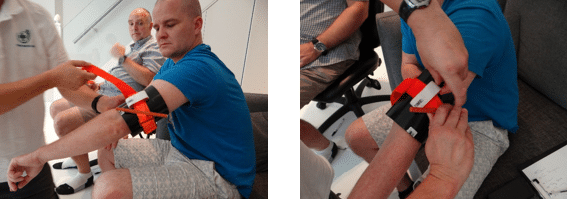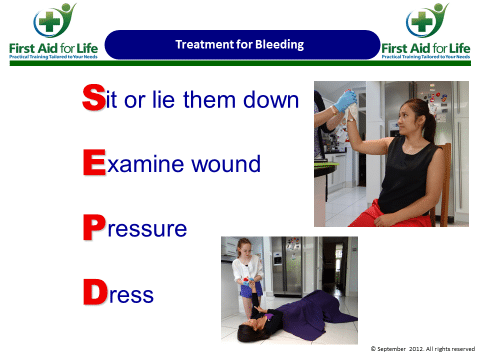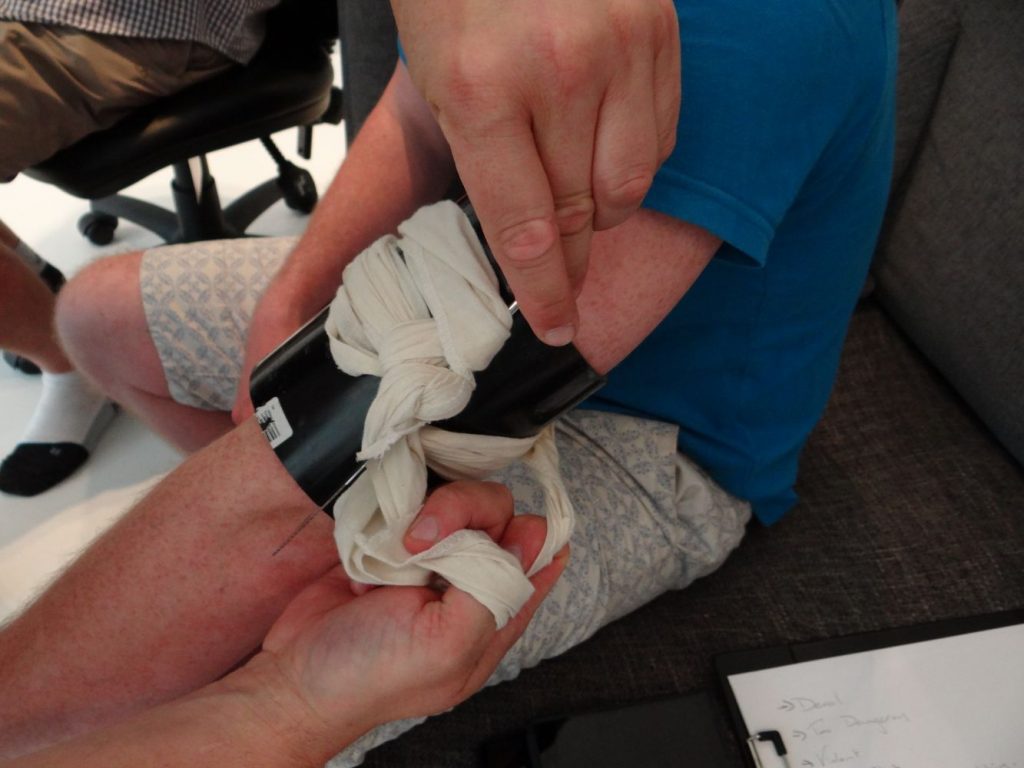Use Tourniquet Again With Blood Draw

The European Resuscitation Council (ERC) First Aid Guidelines 2015 state that when direct pressure cannot control severe bleeding, tourniquets and haemostatic dressings are now advised. ILCOR (International Liaison Committee on Resuscitation) fully supports this
If someone is bleeding extremely heavily from either a major artery or vein, they can quickly lose a lot of blood. The bleeding is likely to pulsate in time with the heart. This is more pronounced with an arterial bleed, but happens within venous bleeds too. With extremely heavy, potentially catastrophic bleeding an adult could easily lose 40% of their blood volume in 3-4 minutes. This could be even quicker when dealing with children.
If a casualty loses a substantial amount of blood – more than 40% of their blood volume, the body is no longer able to compensate for that amount of blood loss. They will develop hypovolaemic shock. Hypovolaemic shock is a low volume of blood causing failure of the circulatory system, if untreated they will die.
Military and civilian research has shown wealth of evidence demonstrating the effectiveness of tourniquets and haemostatic dressings in the treatment of life-threatening bleeding.
Key changes in the new European Resuscitation Guidelines relating to bleeding:
- New guidelines no longer recommend elevation for the control of severe bleeding. Elevation does reduce the flow of blood, but alone it will not stop bleeding. If someone has an arterial bleed, just holding it in the air is not going to stop the bleeding. Applying direct pressure to the source of bleeding is much more likely to stop life-threatening blood flow.
- You should not use indirect pressure points to control severe bleeding. There is more than one artery supplying the blood to each limb. Pressing on pressure points will not be able to stop the blood flow. Finding pressure points can also be very difficult, particularly with the femoral artery.
Click here for a Street Crime First Aid course including catastrophic bleeding and tourniquets
Treatment of Bleeding:

- Encourage the casualty to sit or lie down in the most appropriate position for the location of the wound and the amount of blood lost. If they are feeling dizzy and showing early signs of shock, raise their legs.
- Examine the wound (as quickly as possible) to assess:
- The type and extent of bleeding.
- The source of the bleeding.
- Whether there are any foreign objects embedded in the wound – if so, do not remove them as they will be stemming bleeding, but apply direct pressure either side of the object.
- Apply direct pressure to try and control bleeding. If you control the bleeding with this direct pressure, keep holding for 10 minutes as it takes this long for clots to form.
- Once you control bleeding, dress the wound – if the wound bleeds through the first dressing, apply another on top. If the wound bleeds through the second dressing you should consider alternative options to stop the bleeding.
The first step when treating a catastrophic bleed is always to apply direct pressure. It is still likely to be the first and only solution needed for the casualty.
Please note:
Tourniquets and haemostatic dressings have been introduced as additional options to treat severe catastrophic bleeding. However, direct pressure remains the main choice of treatment and it will control bleeding in the vast majority of cases. The European Resuscitation Council 2015 guidelines state that haemostatic dressings and tourniquets should be used when direct pressure is either not possible or ineffective.
In environments where a catastrophic bleed is likely, tourniquets and haemostatic dressings should be an integral part of the first aid kit. All first aiders should be trained in their use.
As a member of the general public you are highly unlikely to need to use a tourniquet. However understanding how to improvise one, and how and when to use one, could save lives if you're ever involved in a major medical accident or emergency.
Do Improvised Tourniquets Work?
There is ongoing debate around the usefulness of an improvised tourniquet: Stewart SK, Duchesne JC, Khan MA discussed this in their paper – Improvised Tourniquets: obsolete or obligatory: Journal of Trauma Acute Care Surg 2014;78;1. He came to the following conclusion:
"We propose that education on how to expertly construct and apply an improvised tourniquet becomes and integral part of basic life support and pre-hospital emergency care algorithms, for military and civilians alike. In the absence of a commercially produced tourniquet, this simple first aid measure can satisfactorily arrest life-threatening haemorrhage, while minimizing morbidity that other cruder designs may cause."
How to Use an Improvised Tourniquet
Here is one of the easiest ways to make an improvised tourniquet from the contents of a standard first aid kit. Use a triangular bandage folded into a broad fold bandage and to tighten the tourniquet using scissors as a windlass. If you have access to cutlery, such as a table knife, this would be even better. Otherwise you no longer have your scissors available to use.
Please note: A tourniquet should be at least 4cm wide to prevent localised damage to nerve tissues.
- Tie the bandage around the bare limb on a single bone (i.e. if the lower part of the arm or leg are bleeding, you should tie the tourniquet on the upper part, where there is only one bone rather than two).
- The tourniquet should be at least 5cm above the wound, or 5cm above the joint if the wound is on the lower limb. Never place a tourniquet over a joint.
If there's a clean cut through an artery, for example in a deep incised wound, the artery can contract back up the arm or leg. This is why you should place the tourniquet at least 5cm (or 2 inches) above the wound.
You may find other guidance on the positioning of a tourniquet, such as applying the first tourniquet mid-point over a single bone. This advice is also acceptable, so long as the tourniquet is positioned proximal to the wound (closer to the trunk of the body).
Interested in a Street Crime First Aid course including catastrophic bleeding and tourniquets? Click here
1. Place the knife or your scissors on top of the knot and tie another knot on top of them.

2. Use the knife or your scissors as a windlass to wind round and tighten the tourniquet.

3. The windlass can be secured either by tying another triangular bandage to stop it unwinding or by wrapping and tying both ends of the triangular bandage around the ends of the windlass to ensure it remains in place.

Time Factor
It is important to note the exact time in which you applied the tourniquet. To arrange for urgent transfer for medical help, ensure you tell them where and when the tourniquet was applied.
Please note it will be extremely painful for the casualty to have a tourniquet. Howewver it is absolutely vital that you apply the tourniquet tight enough to entirely stop the bleeding.
If a tourniquet is not on tight enough it can make things worse as it can occlude the veins. Arteries may be harder to stop as they are less easy to get to. Moreover, if the venous return is stopped by the tourniquet, the only place for blood to come out is from the wound.
NEVER be tempted to loosen or remove a tourniquet. Once applied, tourniquets should only ever be removed by a doctor in a hospital setting.
Unsuitable but Tempting Alternatives for an Improvised Tourniquet:
A tie is likely to be too thin. A leather belt is also unsuitable as it is too tough to use with a windlass; you will be unable to provide sufficient force by hand to tighten it sufficiently to provide enough pressure to stop the blood flow.
A tourniquet should be at least 4cm wide to prevent localised damage to nerves tissues.
A tourniquet must be put on sufficiently tight to stop the bleeding. If it is not tight enough it can actually end up increasing blood loss. It may be necessary to apply more than one tourniquet to completely stop bleeding.
It is important for the doctor treating the casualty to have a good understanding of how long the tourniquet has been applied for. Write the time the tourniquet was applied onto the tourniquet itself or onto the casualty.
Please remember that although tourniquets can save lives, their use should not be taken lightly. They remain a second-line treatment when direct pressure is not possible or insufficient to control bleeding.

About us
First Aid for Life provide award-winning first aid training tailored to your needs. Please visit our site and learn more about our practical and online courses. It is vital to keep your skills current and refreshed. We are currently providing essential training for individuals and groups across the UK. In addition, we have a great range of online courses. These are ideal as refreshers for regulated qualifications or as Appointed Person qualifications.
You can attend a fully regulated Practical or Online First Aid course to understand what to do in a medical emergency. Please visit https://firstaidforlife.org.uk or call 0208 675 4036 for more information about our courses.
First Aid for Life is a multi-award-winning, fully regulated first aid training provider. Our trainers are highly experienced medical, health and emergency services professionals who will tailor the training to your needs. Courses for groups or individuals at our venue or yours.
First Aid for life provides this information for guidance and it is not in any way a substitute for medical advice. We are not responsible or liable for any diagnosis made, or actions taken on this information.
Use Tourniquet Again With Blood Draw
Source: https://firstaidforlife.org.uk/tourniquets/
0 Response to "Use Tourniquet Again With Blood Draw"
Post a Comment